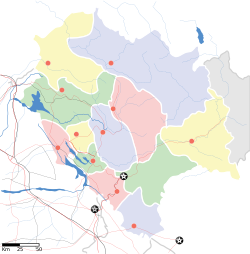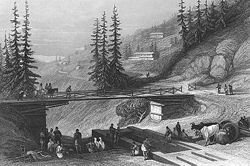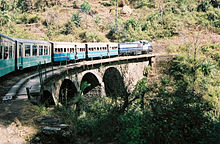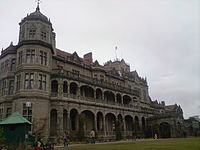Shimla
From Wikipedia, the free encyclopedia
This article is about the municipality in India. For its namesake district, see Shimla district.
| Shimla शिमला | |
| — capital — | |
| Coordinates | 31°6′12″N77°10′20″ECoordinates: 31°6′12″N 77°10′20″E |
| Country | India |
| State | Himachal Pradesh |
| District(s) | Shimla |
| Municipal Commissioner | Onkar Chand Sharma, IAS |
| Mayor | Madhu Sood (INC) |
| Population • Density | 1,44,975 (1st)[1] (2005) • 120 /km2 (311 /sq mi) |
| Official languages | Hindi |
|---|---|
| Time zone | IST (UTC+05:30) |
| Area | 25 km2 (10 sq mi) • 2,205 metres (7,234 ft) |
| Climate | Cwb (Köppen) • 1,577 mm (62.1 in) • 21 °C (70 °F) • 32 °C (90 °F) • 10 °C (50 °F) |
| Website | Official website of Shimla |
Shimla (Hindi: शिमला [ˈʃɪmlaː] ( listen)), formerly known as Simla, is the capital city of Himachal Pradesh. In 1864, Shimla was declared the summer capital of the British Raj in India. A popular tourist destination, Shimla is often referred to as the "Queen of Hills," a term coined by theBritish. Located in the north-west Himalayas at an average altitude of 2,205 metres (7,234 ft), the city of Shimla, draped in forests of pine, rhododendron, and oak, experiences pleasant summers and cold, snowy winters. The city is famous for its buildings styled in tudorbethan and neo-gothic architecture dating from the colonial era. Shimla is connected to the city of Kalka by one of the longest narrow gauge railway routes still operating in India,[2] theKalka-Shimla Railway. Shimla is approximately 145 km (90 mi) from Mandi, 100 km (62 mi) fromChandigarh, the nearest major city, and 365 km (227 mi) from New Delhi, the national capital. The city is named after the goddess Shyamala Devi, an incarnation of the Hindu Goddess Kali.[3]
listen)), formerly known as Simla, is the capital city of Himachal Pradesh. In 1864, Shimla was declared the summer capital of the British Raj in India. A popular tourist destination, Shimla is often referred to as the "Queen of Hills," a term coined by theBritish. Located in the north-west Himalayas at an average altitude of 2,205 metres (7,234 ft), the city of Shimla, draped in forests of pine, rhododendron, and oak, experiences pleasant summers and cold, snowy winters. The city is famous for its buildings styled in tudorbethan and neo-gothic architecture dating from the colonial era. Shimla is connected to the city of Kalka by one of the longest narrow gauge railway routes still operating in India,[2] theKalka-Shimla Railway. Shimla is approximately 145 km (90 mi) from Mandi, 100 km (62 mi) fromChandigarh, the nearest major city, and 365 km (227 mi) from New Delhi, the national capital. The city is named after the goddess Shyamala Devi, an incarnation of the Hindu Goddess Kali.[3]
Contents[hide] |
[edit]History
In 1806, Shimla, along with Almora, Kumaon,Garhwal, Sirmaur, Dehradun and Kangra, was invaded and captured by Prithvi Narayan Shah ofNepal, Shortly later, the British East India Company with local kings went to war with Nepal from 1814 to 1816. At the conclusion of the war, as a result of the Sugauli Treaty, all these captured parts of North India were ceded to the British East India company. At that time, Shimla was known for the temple of Hindu Goddess Shyamala Devi, and not as a city as it is today.
Not long after gaining possession of Shimla, the British began to develop the area. The Scottish civil servant Charles Pratt Kennedy built the first British summer home in the town in 1822. Lord Amherst, the Governor-General of Bengal from 1823 to 1828, set up a summer camp here in 1827, when there was only one cottage in the town, and only 'half a dozen' when he left that year. There were more than a hundred cottages within ten years.[4] Shimla soon caught the eye of Lord William Bentinck, the next Governor-General of Bengal from 1828 (later of India, when the title was created in 1833) to 1835. In a letter to Colonel Churchill in 1832, he wrote[5]
| “ | Simla is only four days march from Loodianah (Ludhiana), is easy of access, and proves a very agreeable refuge from the burning plains of Hindoostaun (Hindustan). | ” |
One of his successors, Sir John Lawrence(Viceroy of India 1864–1869), decided to take the trouble of moving the administration twice a year between Calcutta and this separate centre over 1,000 miles away, despite the fact that it was difficult to reach.[4] Lord Lytton (Viceroy of India1876-1880) made efforts to plan the town from 1876, when he first stayed in a rented house, but began plans for a Viceregal Lodge, later built on Observatory Hill. A fire cleared much of the area where the native Indian population lived (the "Upper Bazaar"), and the planning of the eastern end to become the centre of the European town forced these to live in the Middle and Lower Bazaars on the lower terraces descending the steep slopes from the Ridge. The Upper Bazaar was cleared for a Town Hall, with many facilities such as library and theatre, as well as offices - for police and military volunteers as well as municipal administration.
During the 'Hot Weather', Simla was also the Headquarters of the Commander-in-Chief of the Indian Army and many Departments of the Government, as well as being the summer capital of the regional Government of the Punjab. They were joined by many of the British wives and daughters of the men who remained on the plains. Together these formed Simla Society, which, according to Charles Allen,[6] "was as close as British India ever came to having an upper crust." This may have been helped by the fact that it was very expensive, having an ideal climate and thus being desirable, as well as having limited accommodation. British soldiers, merchants, and civil servants moved here each year to escape from the heat during summer in the Indo-Gangetic plain. The presence of many bachelors and unattached men, as well as the many women passing the hot weather there, gave Simla a reputation for adultery, and at least gossip about adultery: as Rudyard Kipling said in a letter cited by Allen, it had a reputation for "frivolity, gossip and intrigue". (See also.[7])
TheKalka-Shimla railway line, constructed in 1906, added to Shimla's accessibility and popularity. The railway route from Kalka to Shimla, with more than 806 bridges and 103 tunnels, was touted as an engineering feat and came to be known as the "British Jewel of the Orient".[7] In 2008, it became part of the UNESCO World Heritage Site, Mountain railways of India.[8]Not only that, there was a significant Muslimpopulation in the region before the partition ofBritish India. In addition, Shimla was the capital of the undivided state of Punjab in 1871, and remained so until the construction of the new city of Chandigarh (the present-day capital of Punjab)[dubious ] Upon the formation of the state of Himachal Pradesh in 1971, Shimla was named its capital.
Pre-independence structures still dot Shimla; buildings such as the Viceregal Lodge, Auckland House, Gorton Castle, Peterhoff house, and Gaiety Theatre are reminders of British rule in India.[9][10]British Simla extended about a mile and a half along the ridge between Jakhoo Hill and Prospect Hill. The central spine was The Mall, which ran along the length of the ridge, with a Mall Extension southwards, closed to all carriages except those of the Viceroy and his wife.
[edit]Geography
Shimla is located in the north-western ranges of theHimalayas. At an average altitude of 2397.59 meters (7866.10 ft) above mean sea level, the city is spread on a ridge and its seven spurs. The city stretches nearly 9.2 km from east to west.[11] The highest point in Shimla, at 2454 meters (8051 ft), is the Jakhoo hill. Shimla is a Zone IV (High Damage Risk Zone) per theEarthquake hazard zoning of India. Weak construction techniques and increasing population pose a serious threat to the already earthquake prone region.[12][13] There are no bodies of water near the main city and the closest river, Sutlej, is about 21 km (13 mi) away.[14] Other rivers that flow through the Shimla district, although further from the city, are Giri, and Pabbar (both are tributaries of Yamuna). The green belt in Shimla planning area is spread over 414 hectares (1023 acres).[7]The main forests in and around the city are that ofpine, deodar, oak and rhododendron.[15]Environmental degradation due to the increasing number of tourists every year without the infrastructure to support them has resulted in Shimla losing its popular appeal as an ecotourismspot.[16] Another rising concern in the region are the frequent number of landslides that often take place after heavy rains.[12][17]
[edit]Climate
Shimla features a subtropical highland climateunder the Koppen climate classification. The climate in Shimla is predominantly cool during winters, and moderately warm during summer. Temperatures typically range from −4 °C (25 °F) to31 °C (88 °F) over the course of a year.[18] The average temperature during summer is between19 °C (66 °F) and 28 °C (82 °F), and between−1 °C (30 °F) and 10 °C (50 °F) in winter. Monthlyprecipitation varies between 15 millimetres (0.59 in) in November to 434 millimetres (17.1 in) in August. It is typically around 45 millimetres (1.8 in) per month during winter and spring and around 175 millimetres (6.9 in) in June as the monsoonapproaches. The average total annual precipitation is 1,575 millimetres (62 in), which is much less than most other hill stations but still greatly heavier than on the plains. Snowfall in the region, which historically has taken place in the month of December, has lately (over the last fifteen years) been happening in January or early February every year.[19]
| [hide]Climate data for Shimla | |||||||||||||
|---|---|---|---|---|---|---|---|---|---|---|---|---|---|
| Month | Jan | Feb | Mar | Apr | May | Jun | Jul | Aug | Sep | Oct | Nov | Dec | Year |
| Record high °C (°F) | 17.2 (63.0) | 19.4 (66.9) | 23.9 (75.0) | 28.3 (82.9) | 30.0 (86.0) | 30.6 (87.1) | 27.8 (82.0) | 25.6 (78.1) | 24.4 (75.9) | 23.9 (75.0) | 19.4 (66.9) | 20.0 (68.0) | 30.6 (87.1) |
| Average high °C (°F) | 8.3 (46.9) | 8.9 (48.0) | 13.9 (57.0) | 18.3 (64.9) | 22.2 (72.0) | 22.8 (73.0) | 20.6 (69.1) | 19.4 (66.9) | 19.4 (66.9) | 17.2 (63.0) | 13.9 (57.0) | 10.6 (51.1) | 16.3 (61.3) |
| Average low °C (°F) | 2.2 (36.0) | 2.8 (37.0) | 6.7 (44.1) | 11.1 (52.0) | 14.4 (57.9) | 16.1 (61.0) | 15.6 (60.1) | 15.0 (59.0) | 13.9 (57.0) | 10.6 (51.1) | 7.2 (45.0) | 4.4 (39.9) | 10.0 (50.0) |
| Record low °C (°F) | −9.4 (15.1) | −7.7 (18.1) | −5.6 (21.9) | 0.0 (32.0) | 4.4 (39.9) | 7.8 (46.0) | 10.0 (50.0) | 11.1 (52.0) | 5.0 (41.0) | 3.9 (39.0) | 0.0 (32.0) | −6.1 (21.0) | −9.4 (15.1) |
| Precipitationmm (inches) | 61 (2.4) | 69 (2.72) | 61 (2.4) | 53 (2.09) | 66 (2.6) | 175 (6.89) | 424 (16.69) | 434 (17.09) | 160 (6.3) | 33 (1.3) | 13 (0.51) | 28 (1.1) | 1,577 (62.09) |
| Source: Worldwide Bioclimatic Classification System[20] | |||||||||||||
[edit]Economy
Employment is largely driven by the government and tourism.[21] Education and horticultural produce processing, comprise most of the remainder.
In addition to being the local hub of transportation and trade, Shimla is the area's healthcare centre, hosting a medical college and four major hospitals:[22] the Indira Gandhi Hospital (formerly known as Snowdown Hospital,) Deen Dayal Upadhyay Hospital (formerly called Ripon Hospital,) Kamala Nehru Hospital, and Indus Hospital. The city's development plan aims make Shimla an attractive health tourism spot.[21]
Government is trying to promote technology and IT sector as the new area for growth and promotion[23] although not many companies have yet settled in Shimla. Few notable companies that are registered in Shimla are Avant Garde Digital, an international company and instablogs, a company that deals with media publishing.
[edit]Civic administration
The administrative responsibilities of the city of Shimla and the surrounding planning areas of Dhalli, Tutu, and New Shimla reside with the Shimla Municipal corporation. Established in 1851, the Shimla municipal corporation is an elected body comprising 27 councilors 3 of which are nominated by the government of Himachal Pradesh.[11] The nominations are based on prominence in the fields of social service, academics and other activities. 33% seats are reserved for women. The elections take place every five years and the mayor and deputy mayor are elected by and amongst the councilors themselves. As of June 2008, the two major political parties are the Indian National Congress(in Opposition) and Bharatiya Janata Party (BJP) (in power).[24] The administrative head of the corporation is the commissioner who is appointed by the state government.
The city contributes one seat to the state assembly (Vidhan Sabha), and one seat to the lower house of parliament (Lok Sabha).[25] Law and order in the city is collectively maintained by the Police department, Vigilance Department, Enforcement directorate, Forensics, Fire department, department of prisons, and Home Guard department. There are five police stations and three fire stations in Shimla.[26] TheSuperintendent of Police, Shimla heads the police department. The First Armed Police Battalion, one of the four armed police battalions in the state, is also available for assistance to the local police for assistance.[27] There are eleven courts in the district including a fast-track court[28]
[edit]Demographics
Shimla city consists of the Shimla municipal corporation and Shimla planning areas (SPA). The SPAs are Dhalli, Tutu, and New Shimla urbanagglomerations. As per the 2001 India Census,[29]the city has a population of 1,042,161 spread over an area of 19.55 km².[11] A floating population of 75,000 is attributed to service industries such as tourism.[11] The largest demographic, 55%, is 16–45 years of age. A further 28% of the population are younger than 15 years. The low sex ratio – 930 girls for every 1000 boys in 2001[30] – is cause for concern, even though it is not atypical of the region.
The unemployment rate in the city has come down from 36% in 1992 to 22.6% in 2006. This drop is attributed to recent industrialization, the growth of service industries, and knowledge development.[31]84% of the population of Shimla city is literate, compared to 80% in Shimla district and 83.87% in the entire state.[32] The majority of Shimla's population consists of natives of Himachal Pradesh. Pahari, Hindi, Punjabi are the main languages. The major religion is Hinduism (93.5%), followed by Sikhism (2.5%) and small minorities ofChristians, Tibetan Buddhists and Muslims.[33]
[edit]Culture
The people of Shimla are informally called Shimlaites. With largely cosmopolitan crowds, a variety of festivals are celebrated here. The Shimla Summer Festival, held every year during peak tourist season,[34] and lasting 3–4 days, is celebrated on the ridge. The highlights of this event include performances by popular singers from all over the country.[35] Shimla has a number of places to visit. Local hangouts like the mall road and ridge are in the heart of the city. Most of the heritage buildings in the city are preserved in their originaltudorbethan architecture. The Viceregal lodge which houses the Indian Institute of Advanced Study, and Wildflower hall that is now a luxury hotel are some of the famous ones. A collection of paintings, jewellery and textiles of the region can be found at the State Museum (built in 1974). Further out from the city is the Naldehra nine-hole golf course, the oldest of its kind in India.[36] Kufriis a ski resort (winter only) located 19 kilometres (11.8 mi) from the main city. Lakkar Bazaar, a market extending off the ridge, is famous for souvenirs and crafts made of wood. Tatta Pani, 55 kilometres (34.2 mi) from the main city, is the name of hot sulphur springs that are believed to have medicinal value located on the banks of riverSatluj. Shimla is also home to South Asia's only natural ice skating rink.[37] State and national level competitions are often held at this venue. The Shimla Ice Skating Club, which manages the rink, hosts a carnival every year in January, which includes a fancy dress competition and figure skating events. Due to effects of global warming and increasing urban development in and around Shimla, the number of sessions on ice every winter have been decreasing in the past few years.
Shimla has many temples and is often visited by devotees from nearby towns and cities. The Kali Bari temple, dedicated to the Hindu goddess Kaliis near the mall. Jakhoo Temple, for the Hindu godHanuman is located at the highest point in Shimla[citation needed]. Sankat Mochan, anotherHanuman temple, is famous for the numerous monkeys that are always found in its vicinity. It is located on Shimla-Kalka Highway about 10 kilometres (6.2 mi) from the city. The nearby temple of Tara Devi is a place for performing rituals and festivals. Other prominent places of worship include a Gurudwara near the bus terminus and aChurch on the ridge.
[edit]Education
The city has 14anganwadis and 63 primary schools.[11] There are many schools from the British era. Some of the popular schools in the city are Bishop Cotton School, Auckland House School, Shimla Public School, St Edwards School, Tara Hall, Chelsea, Hainault Public School, DAV Lkr Bazaar, DAV New Shimla,, Dayanand Public School, Himalayan International School at Chharabra, and Chapslee School. Where Auckland House School, Tara Hall, and Chelsea are for girls only.
The medical institutes in Shimla are Indira Gandhi Medical College and Dental college. St. Bedes and Rajkiya Kanya MahaVidayaliya (RKMV) are girls-only colleges. Government College, Sanjauli, and Government College Chaura Maidan are also located in the city. The Indian Institute of Advanced Study, housed in the Viceregal lodge, is a residential centre for research in Humanities, Indian culture, religion, and social and natural sciences. The Himachal Pradesh University is also based in Shimla. University Institute of Information Technology, Himachal Pradesh University (UIIT), a premier institute to provide technical education in the state is located here.
There are many private institutions.
Shimla has two state libraries with a collection of over 47,000 old books divided between them. The one at Gandhi Bhavan in the University has over 40,000 books and the other library, also a heritage building on the ridge, has 7000.[38]
Other institutes of higher education and research located in Shimla are the Central Potato Research Institute, a member of Indian Council of Agricultural Research (ICAR), and National Academy of Audit and Accounts for training of officers of the Indian Audit and Accounts services (IA&AS).
[edit]Places of interest
The Mall: The Mall is the main shopping street of Shimla. It also has many restaurants, clubs, banks, bars, Post Offices and tourist offices. The Gaiety Theatre is also situated there. People walk up and down the Mall slowly, stopping to gossip, as it is the main meeting place for everyone. The Ridge and Scandal point are the two main meeting points at the Mall. The mall is dotted with many eating places .The most famous among them is Trishul bakery which is known for its pastries.
Christ Church: Situated on the Ridge, Christ Church is the second oldest church in Northern India. It has a very majestic appearance and inside there are stained glass windows which represent faith, hope, charity, fortitude, patience and humility.
Jakhu Hill: 2 km from Shimla, at a height of 8000 ft, Jakhu Hill is the highest peak and offers a beautiful view of the town and of the snow-covered Himalayas. At the top of the Hill, is an old temple of Lord Hanuman, which is also the home of countless playful monkeys waiting to be fed by all visitors.
Shimla State Museum: The Museum, which was opened in 1974, has tried to protect hill-out and the cultural wealth of the state. There is a collection of miniature Pahari paintings, sculptures, bronzes wood-carvings and also costumes, textiles and jewellery of the region.
Indian Institute of Advanced Study: This institute is housed in the Viceregal Lodge, built in 1884-88.
Summer Hill: Situated at a distance of 5 km from the Ridge is the lovely township of Summer Hill at a height of 6,500 ft on the Shimla-Kalka railway line. Mahatma Gandhi lived in these quiet surroundings during his visits to Shimla. Himachal Pradesh University is situated here.
Annandale: Developed as the playground of Shimla, Annandale is 2–4 km from the Ridge at a height of 6,117 ft. It is a favourite spot for cricket, picnics and polo.
Tara Devi: 11 km from the Shimla bus-stand. Tara Devi hill has a temple dedicated to the goddess of stars on top of the hill. There is a military Dairy Town here as well as the headquarters of Bharat Scouts and Guides.
Sankat Mochan: A Lord Hanuman temple is located here.
Junga: Junga is near Tehsi, 26 km from Shimla. Its original name (with diacritics) is Jūnga and is a former royal retreat of the princely state of Junga, also known as Keonthal Estate.
Anand Vilas: Midway between Shimla and Junga. "Sarva Dharma Mandir", Temple of all Faiths, is a spiritual group dedicated to Mother Nature. Thousands of visitors and devotees come here every year. There is an "Art is Values" school with students from all over India. Classes are provided free of cost.
Mashobra: 13 km from Shimla, site of the annual Sipi fair in June.
Kufri: 16 km from Shimla at a height of 8,600 ft, Kufri is the local winter sports centre, and it also has a small zoo.
Chharabra: 13 km from Shimla on route to Kufri.
Naldehra: 22 km from Shimla, with a nine-holeNaldehra Golf Club. The annual Sipi fair in June is held in Naldehra.
Chail: Chail was the summer capital of the Maharaja of Patiala before Independence, known for its cricket pitch, the highest in the world.
Arki: (46 km) is the site of an 18th century fort built when Arki was the capital of the erstwhile hill state of Baghal
Tatapani: Location of sulphur springs which are found near the Tatapani mandir(holy temple)
Sanjauli: The main suburb of Shimla.
A 108 feet (33 metre) statue of Lord Hanuman, aHindu deity, at 8,500 feet (2,591 metres) above sea level, is the highest statue in the world, overtaking the Christ Redeemer in Rio de Janeiro,Brazil .[39]
[edit]Transport
Local transport in Shimla is by bus or private vehicles. Buses ply frequently on the circular road surrounding the city centre. Tourist taxis are also an option for out of town trips. Locals typically traverse the city on foot. Private vehicles are prohibited on the mall, ridge, and nearby markets. Due to narrow roads and steep slopes, the auto rickshaws common in other Indian cities are largely absent.
Shimla is well-connected by road and rail. TheNational Highway 22 (NH 22) connects Shimla to the nearest big city of Chandigarh. The scenicKalka Shimla Railway, a narrow gauge track, is listed in the Guinness Book of Records for the steepest rise in altitude in a distance of 96 km.[40]Kalka, the plains rail terminus, has daily departures to major Indian cities. Flights fromShimla Airport at Jubbarhatti (12 km away)[41]connect Shimla to Delhi.
[edit]Sister cities
Sister relationships with towns and regions worldwide include:

























No comments:
Post a Comment